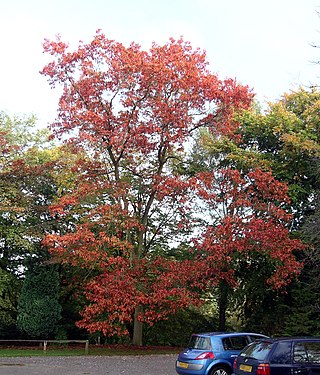
Quercus rubra, the northern red oak, is an oak tree in the red oak group. It is a native of North America, in the eastern and central United States and southeast and south-central Canada. It has been introduced to small areas in Western Europe, where it can frequently be seen cultivated in gardens and parks. It prefers good soil that is slightly acidic. Often simply called red oak, northern red oak is so named to distinguish it from southern red oak (Q. falcata), also known as the Spanish oak. Northern red oak is sometimes called champion oak.

Quercus montana, the chestnut oak, is a species of oak in the white oak group, Quercus sect. Quercus. It is native to the eastern United States, where it is one of the most important ridgetop trees from southern Maine southwest to central Mississippi, with an outlying northwestern population in southern Michigan. It is also sometimes called rock oak because of its presence in montane and other rocky habitats.

Quercus alba, the white oak, is one of the preeminent hardwoods of eastern and central North America. It is a long-lived oak, native to eastern and central North America and found from Minnesota, Ontario, Quebec, and southern Maine south as far as northern Florida and eastern Texas. Specimens have been documented to be over 450 years old.

Quercus robur, the pedunculate oak, is a species of flowering plant in the beech and oak family, Fagaceae. It is a large tree, native to most of Europe and western Asia, and is widely cultivated in other temperate regions. It grows on soils of near neutral acidity in the lowlands and is notable for its value to natural ecosystems, supporting a very wide diversity of herbivorous insects and other pests, predators and pathogens.

Quercus laurifolia is a medium-sized semi-evergreen oak in the red oak section Quercus sect. Lobatae. It is native to the southeastern and south-central the United States.
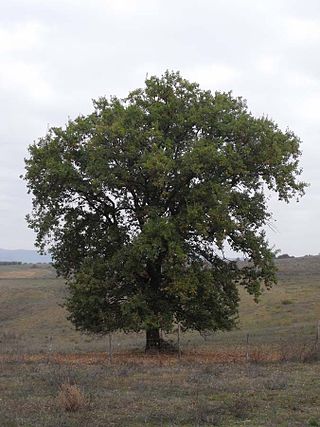
Quercus pubescens, commonly known as the downy oak, pubescent oak or Italian oak, is a species of white oak native to southern Europe and southwest Asia. It is found from northern Spain (Pyrenees) and France in the West to Turkey and the Caucasus in the East.

Quercus imbricaria, the shingle oak, is a deciduous tree in the red oak group of oaks. It is native primarily to the Midwestern and Upper South regions of North America.
Quercus asymmetrica is an oak tree species in the beech family Fagaceae. It is found in China and northern Vietnam. It is placed in subgenus Cerris, section Cyclobalanopsis.

Quercus hypoleucoides, the silverleaf oak or the whiteleaf oak, is a North American species of oak tree or shrub. It grows in the southwestern United States and northern Mexico.
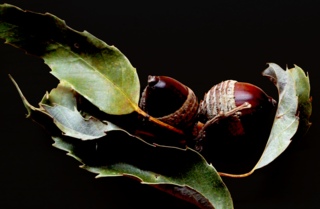
Quercus stenophylloides, also called Arisan oak, is a species of evergreen, broad-leaf tree endemic to Taiwan. It is placed in Quercus subgenus Cerris, section Cyclobalanopsis.
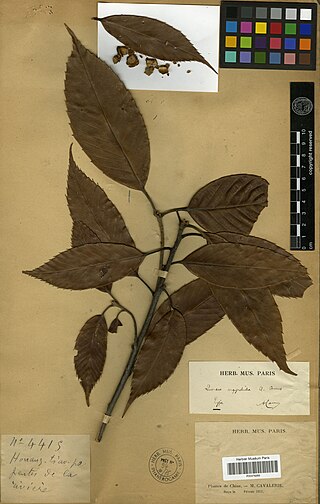
Quercus argyrotricha is a rare Chinese species of trees in the beech family. It has been found only in Guizhou Province in southern China. The common name is Chinese for this species is gui zhou qing gang.
Quercus austrocochinchinensis is an uncommon species of tree in the beech family Fagaceae. It has been found in Vietnam and Thailand as well as Yunnan Province in southern China. It is placed in subgenus Cerris, section Cyclobalanopsis.
Quercus camusiae is an uncommon species of tree in the family Fagaceae. It has been found in Vietnam and southern China (Yunnan).

Quercus rex is an Asian species of tree in the family Fagaceae. It has been found in the seasonal tropical forests of northern Indochina, northeastern India, and also in the province of Yunnan in southwestern China. It is placed in subgenus Cerris, section Cyclobalanopsis.
Quercus thorelii is an Asian species of tree in the beech family Fagaceae. The species is named after the French botanist Clovis Thorel. It has been found in Indochina and in southern China. It is placed in subgenus Cerris, section Cyclobalanopsis, the ring-cupped oaks.
Quercus langbianensis is an uncommon oak tree species in the family Fagaceae. It is placed in subgenus Cerris, section Cyclobalanopsis, the ring-cupped oaks. These differ from other Quercus groups in that they have acorns with distinctive cups: usually with substantial rings, made-up of scales that have grown together. This species can be found in sub-tropical and tropical seasonal forests of Vietnam.
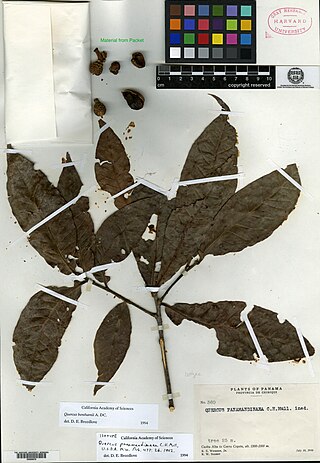
Quercus panamandinaea is a species of oak tree native to Costa Rica and Panama. It belongs to Quercus sect. Lobatae within Quercus subg. Quercus and is named after its distribution in Panama and the Andean region. It prefers a wet, tropical biome.
Quercus rekonis is a species of oak in the subgenus Quercus indigenous to Mexico. It was described in 1924 by William Trelease. It is most commonly found in the Mexican state of Oaxaca, but can be found throughout much of western Mexico. Quercus rekonis grows in a subtropical biome.
Quercus blaoensis is the accepted name of a critically endangered oak tree species. It is estimated that there are fewer than 50 mature individuals. This species belongs the Asian sub-genus of Quercus within the family Fagaceae. It differs from other Quercus subgenera in that they have acorns with distinctive cups, characterised by growing rings of scaly protrusions and densely grouped acorns. This species is endemic to southeastern Vietnam where it inhabits evergreen seasonal tropical forests at altitudes of 200–1100 metres. It is named after 'Blao', the name used by the Chau Ma minority people for Bảo Lộc.












